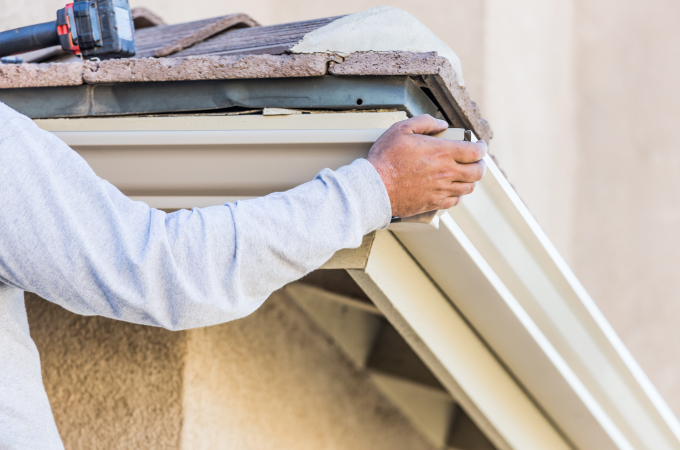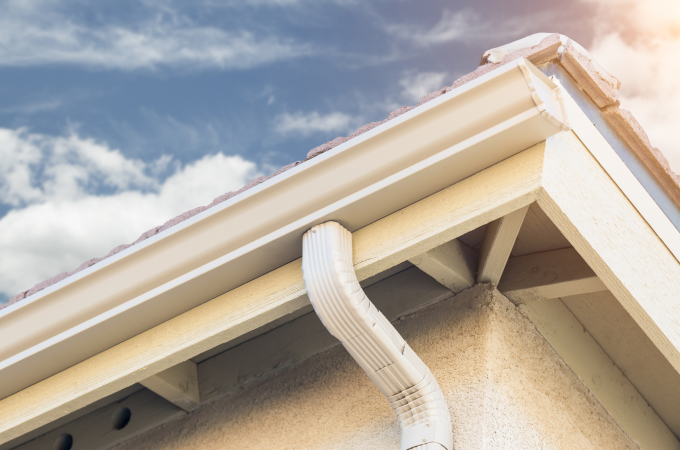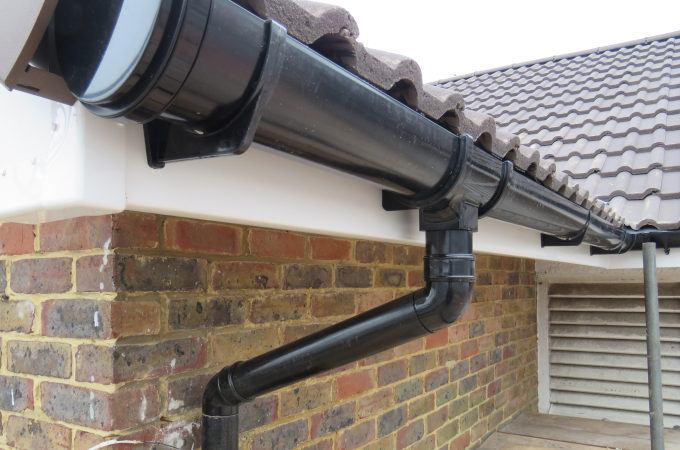Anyone who is going to operate a gutter machine must first read and understand the manual provided by the machine manufacturer. The first reason is the safety of the operator—the manual will guide you on safe practices that will help you avoid personal injury. The second reason is to properly operate the machine so it will produce hi-quality gutter and avoid damage to the machine.
A seamless gutter machine typically produces about 30 feet of gutter per minute. It usually only needs to be operated a few minutes per day to produce the gutter required for that day’s work.
In most cases the gutter machine will have been transported to the worksite with a coil of material on the machine and then run through the machine. Remove the cover tarp from the machine, if present. Verify that the coil of material in the machine is correct for the job to be run.
Obtain an electric extension cord of the necessary length and appropriate size (based on the line cord length and load) to reach electric power. Verify that the power circuit has adequate capacity. Connect the power cord through a ground fault detector, if possible. If connecting directly to a generator, verify that the generator capacity is sufficient to run the gutter machine.
The operator should not wear any loose-fitting clothing, jewelry, etc., which could be caught in moving parts of the machine. Safety goggles and gloves are highly recommended.
Because of the danger of electric shock, and the possibility of damage to the machine, it is recommended that the gutter machine never be operated when rain or snow can fall onto the machine unless the machine is mounted inside an enclosed trailer or truck.
Before starting operation, the operator should:
- Visually check the electrical components and wiring to assure there are no signs of any heat discoloration or damage.
- Be sure all safety covers on the gutter machine are closed and secured in place to prevent dirt, dust, and foreign objects from entering the machine.
- Remove the spool retaining pin from the spool of coil that is threaded through the machine.
- Verify that the Forward/Reverse switch is in the Forward position.
- Position run out stands at 8- to 10-foot intervals to support the gutter that will come out of the machine.
- Lubricate the blade of the shear with the lubricant recommended in the operation manual. DO NOT use WD-40 on the shear blade or the machine unless specifically recommended by the operation manual.
- Start the machine and run out enough gutter to clear all material that was in the machine path during transport. Cut off and discard. This step is only necessary for machines that have a steel rolled drive system (Panther, Watertite). Free floating polyurethane drive roll systems do not require coil in the machine for transport (Ironman, New Tech).
- Run about seven to ten feet of gutter through the machine as a check sample. Stop the machine and cut off the piece. Inspect the gutter carefully for:
- Proper shape
- Paint damage (peeling, flaking, scratches, etc.)
- Surface imperfections from the rollers
- Any other irregularities
If any problems are detected, diagnose the cause and make corrections before proceeding. If adjustments are required, shut off the machine and disconnect the power line.
Incorrect alignment of material in the machine is the most common cause of problems with a gutter machine. This can result from:
- Incorrect adjustment of the entrance guides
- Incorrect adjustment of the stations
Be sure that necessary adjustments are performed by someone who has been properly trained in how to adjust the machine.
When it is verified that the gutter sample meets the job requirements, proceed with the production of the necessary pieces of gutter.
The operator should learn what the machine sounds like when running properly and make a practice of listening to the machine when running gutter. If the machine begins making unusual sounds it probably means something is wrong and needs to be cleaned, lubricated, adjusted, or repaired.
Changing Spools
If it is necessary to change the material to be run (for instance, because of paint color requirements):
- Make sure the loading area is clean and free of debris.
- Cut the existing material between the spool and the entrance guide system.
- Install the spool retaining pin.
- Run the end piece of material out of the machine. Discard this piece.
- If the alternate material coil is already on another spool on the spool rack, remove its spool retaining ring and proceed with threading, as below, according to the operation manual.
- If the coil must be removed and a new coil loaded on to the machine, follow the instructions of the operating manual.
CAUTION A COIL OF MATERIAL IS EXTREMELY HEAVY. USE APPROPRIATE LIFTING EQUIPMENT AND ASSISTANCE, AS REQUIRED.
Pull the end of the coil off the spool. Cut both of the leading corners of the material at 45° angles, approximately 3 inches in from the corner. Insert the trimmed edges of the material into the entrance guides and push forward to the first drive rollers. Jog the material through the machine. Stop at each station to verify that the material is feeding properly and running smoothly through the rollers. If any problems occur, reverse the material a short distance, determine the problem, and clear the obstruction.
- Jog the material until the end has passed the shear.
- If any problems developed, after they have been corrected, run the distorted material out of the machine, cut it off, and discard.
- Close and secure all safety and access covers before proceeding to produce gutter.
When the required gutter has been produced, turn off the machine, disconnect it from the electric power circuit, and reinstall the spool retaining pin. If this is the last run before transporting the machine to a new site, confirm that material is threaded through the entire machine to protect the rollers from roller-to-roller impact damage. (This does not apply for New Tech Machinery and KWM Ironman units which can be safely transported without coil material between the rollers.) Cover the machine with a tarp or gutter machine cover to protect it from external debris and weather.
DO NOT DUMP OLD GUTTER OR DOWNSPOUTS FROM A CUSTOMER’S LOCATION INSIDE THE TRUCK OR TRAILER WITH THE GUTTER MACHINE.
DIRT, LEAVES, AND OTHER DEBRIS MAY GET ON OR IN THE GUTTER MACHINE AND CAUSE DAMAGE.
 Contractors
Contractors



